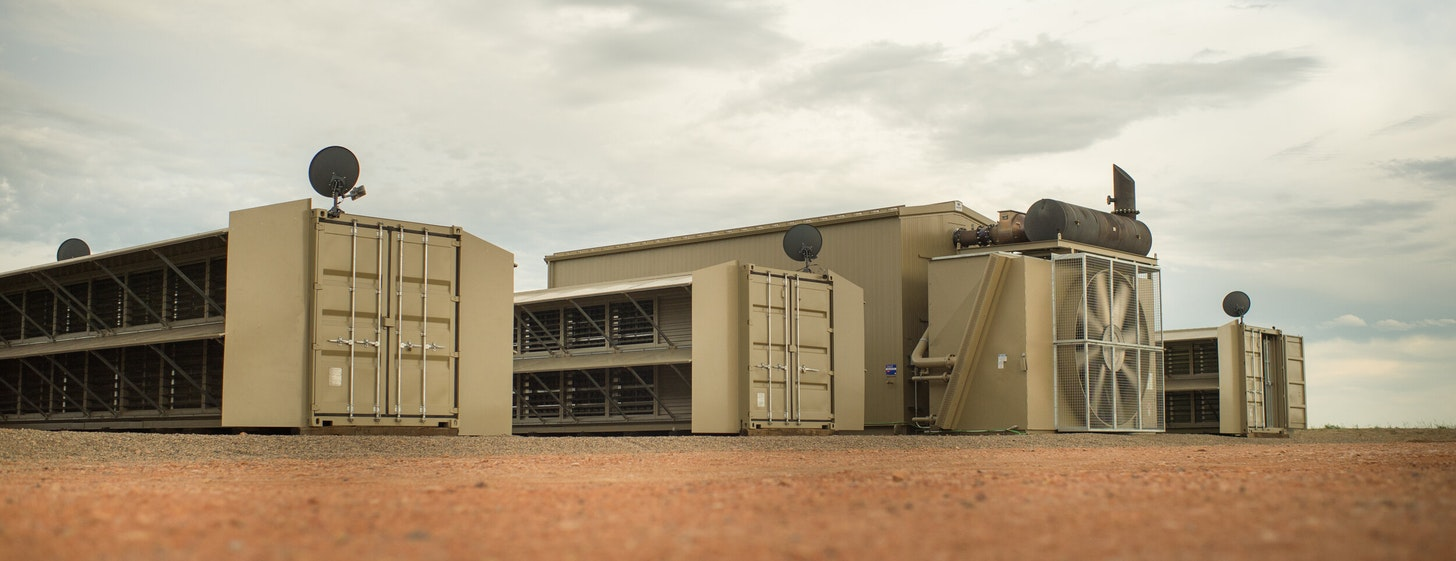· 12 min read
Love it or loathe it, bitcoin is here to stay. The power-hungry digital currency is going from strength to strength, soaring to a series of all-time highs since the New Year and winning a string of high-profile corporate backers along the way. All this has cemented its position as the world’s leading cryptocurrency by market capitalisation.
There are few topics in modern finance as divisive as bitcoin, and its intense energy consumption is a major bone of contention. Every time the price rallies, the debate becomes as heated as the ASIC mining rigs endlessly crunching numbers in far flung corners of the world to keep the bitcoin network running 24/7.
Bitcoin’s electricity consumption will only increase with adoption. A requirement for ever-greater computing power is baked into the system: every four years or so the ‘reward’ for mining bitcoins halves, meaning twice the hashing power is needed to ‘mint’ each new coin.
At the current trajectory, bitcoin’s spiralling energy requirement promises to disrupt upstream energy production in all manner of ways – some of them very positive – and yet the energy industry is barely starting to engage with the technology.
In short, if bitcoin achieves its full potential and replaces fiat currencies around the world – the so-called ‘hyperbitcoinisation’ of the economy that bitcoin acolytes eulogise about – then early adopters will essentially replace central banks at the heart of this new digital financial ecosystem. Energy incumbents are in a privileged position to take a big slice of that market, but short-termism and a lack of vision seem to be standing in the way.

Money = energy
But let’s rewind a moment. Why does bitcoin consume so much power in the first place? (If you’re already au fait with this, skip to the next section.)
Bitcoin’s insatiable power demand – equivalent to that of Switzerland, according to one estimate – is at the heart of the ‘proof of work’ system of cryptographic consensus that makes the bitcoin network and the transactions it supports secure, resilient and trustless.
In simple terms, bitcoin’s proof of work algorithm requires a market participant to demonstrate that a certain amount of computational effort has been put into producing a block on the bitcoin blockchain.
Bitcoin miners around the world compete to be the first to mine the next block by ‘hashing’, or churning through reams of digits, to earn transaction fees and mint new bitcoins in reward. The greater the miner’s processing power, the greater its chance of winning the number-crunching race. This establishes a direct correlation between a miner’s energy usage and its competitiveness.
The power price is thus a fundamental determinant of the profitability of any mining operation, which is why miners are constantly scouring the world for cheap sources of electricity: electrons generated a long way from demand centres, in an over-supplied market, whose production is subsidised – or a combination of these factors.
China remains the world’s capital of bitcoin mining and hashing power thanks to abundant supplies of subsidised capacity, much of which runs on coal. This severely tarnished bitcoin’s environmental credentials, providing rhetorical ammo to sceptics and environmental campaigners who question the cryptocurrency’s ethical legitimacy.
China’s hegemony in hashing capacity is not total. Small but significant mining operations are also active in the US, Russia, Kazakhstan, Malaysia, Iran, Canada, Germany, Norway, Iceland and Venezuela – all home to sources of cheap electricity, be that from subsidised zero marginal cost hydroelectric dams, nuclear stations, solar PV arrays or wind farms. And sales of ASIC mining equipment are growing fastest outside China.
Birth of a Norwegian pioneer
There are signs that some big energy players are waking up to bitcoin. A significant announcement in early March sent ripples through the cryptocurrency world but went almost unnoticed in mainstream energy press: the launch of Seetee by Norwegian industrial energy titan Aker.
Seetee is Aker’s new bitcoin arm, dedicated to investing in mining operations that convert stranded or intermittent electricity without stable local demand – wind, solar, hydropower – into “economic assets that can be used anywhere”. In the words of Aker chairman Kjell Inge Røkke:
“Bitcoin is, in our eyes, a load balancing economic battery, and batteries are essential to the energy transition required to reach the targets of the Paris Agreement. Our ambition is to be a valuable partner in new renewable projects.”
So, a company that derives the vast majority of its income from oil exploration and production is to leverage bitcoin as a means of shoring up the economics of intermittent wind and solar projects, perhaps enabling some that would not otherwise get built.
Seetee believes bitcoin’s role as an economic battery can transform wind and solar into baseload power sources by mopping up structural excesses, preventing curtailment and boosting power plant revenues. This is beneficial to grid balancing, as demand-side load shifting can only do so much.
Also, bitcoins mined this way could be reinvested into building new renewable projects, creating a virtuous economic cycle along which electrons are converted into bitcoin and back again. There will probably be technical impediments, but the idea is an interesting one.
Røkke’s letter to Aker shareholders is worth reading in full to understand how a Norwegian entrepreneur who made his fortune in fishing and, later, oil and gas sees bitcoin as the next great business opportunity in the energy transition. The letter is a freewheeling philosophical examination of risk perception, monetary policy, data privacy, the need for businesses to constantly innovate – and the risk of missing out on bitcoin’s enormous upside potential.
Spinning gold from straw
Røkke’s visionary leadership is rare among energy industry magnates. Bitcoin mining is only just starting to gain awareness as a highly versatile and profitable means of unlocking stranded energy sources, such as associated gas.
There are a few upstream operators harnessing this waste gas at remote oil fields to power mobile bitcoin mining rigs. A few pioneering US companies specialise in leasing gas-to-power mining units to upstream operators or providing them with turnkey hashing solutions.
One of them – Crusoe Energy Systems – at one time partnered with Norwegian state oil company Equinor in the Bakken shale oil play in North Dakota. The setup typically involves laying a short pipeline from the oil well to a small onsite gas-to-power generator; power conditioning equipment; and a rig of fan-cooled ASIC mining computers.
Using waste gas for mining allows oil producers on one side of the world to use a worthless stranded energy asset to produce an increasingly valuable digital commodity – in direct competition with others on the network.
Some proponents of gas-fired mining claim that they are displacing coal-fired bitcoin miners in China. Taken at face value, this means bitcoin mining is opening up a new digital frontier in the push to replace coal with cleaner-burning natural gas in China and across much of Asia.

Eschewing the laws of physics
In reality, a gas-fired miner is competing with all the other miners, including those fuelled by genuinely low- or zero-carbon power sources. But let’s hold that thought and explore the significance of (theoretical) coal-to-gas switching via bitcoin mining.
Until now, converting a heating system from coal to gas required natural gas molecules to be physically present in the same location as the coal furnace. In the power sector, the gas molecules must generate electricity onto the same network as a coal-fired power station.
To achieve this physical proximity, the CH4 molecules must be drilled from a hydrocarbons reservoir, gathered, processed and then piped over long distances to the end-use location. For American, Russian or African gas to compete with coal in Asia, it must also be liquefied, loaded, shipped over even longer distances, unloaded, regasified and injected into the local gas network at the consumption end of the chain. At every step, energy is consumed and often some methane leaks out.
Bitcoin is upending the assumption that fuel replacement requires physical proximity. At mobile bitcoin mining rigs at US or Russian oil fields, the gas molecules need travel only a few hundred feet rather than halfway around the world (and thereby avoid the inefficiencies inherent in producing and transporting liquefied natural gas).
Bitcoin won’t be denting LNG trade any time soon, but widespread adoption could help address the problem of routine venting or flaring of gas at conventional oil fields and shale plays. This practice persists because infrastructure does not exist to pipe the gas to market, or there is no spare capacity on the pipeline at a price that makes it worthwhile to do so.
If low wholesale gas prices render solutions to these obstacles uneconomic, the status quo prevails: methane is released unabated into the atmosphere, it is re-injected to the well to pump more oil, or it is burned at flare stacks that light up the prairie.
The American shale patch has earned an unwelcome accolade for wasting obscene volumes of methane during the hydraulic fracturing of oil-rich shale deposits. The shale boom has helped put US gas flaring on a par with that of Russia, Iran and Iraq, the world’s worst offenders, and beyond that of Venezuela, Algeria and Nigeria – other major gas flaring culprits, according to World Bank data.
As the climate debate intensifies, investors are more closely scrutinising the environmental metrics of upstream operators. Associated gas is becoming a reputational liability for oil producers that have grown accustomed to freely venting and flaring endless volumes of the climate-heating fuel. It could soon become an economic liability too, if regulators finally come good on promises to crack down on routine flaring.
For this reason, oil producers with too much gas on their hands can make it available for bitcoin hashing at a negligible cost to the mobile mining outfits – giving them a competitive edge over rivals that must pay a generator directly, or draw power from the grid.
Transformative opportunity
The addition of associated gas to the bitcoin miners’ global fuel mix is neither here nor there for the mining ecosystem; it makes no difference whether a coin was minted using electricity derived from hydro, wind or gas-fired power. But it could prove transformative for those energy companies sitting on stranded gas resources: technically insolvent US shale players, chastened independents, cash-strapped energy majors and Covid-weary national oil companies.
As the bitcoin price surged – from highs of $1,000 per coin in 2013 to $20,000 in 2017, and then on to ~$60,000 today – the profitability of mining rose in tandem. The most bullish forecasters now foresee bitcoin hitting six figures as soon as this year, and $1 million before mid-decade. It might happen later than that, but the timing matters not: current monetary policy is debasing fiat currencies, pulling the inflection point towards a hyperbitcoinised economy steadily closer.
The conversion of stranded gas into bitcoins thus makes a lot of economic sense. One is a carbon-emitting fossil commodity with zero wellhead value that, even when it finds a route to market, is on a path of secular (albeit gradual) decline. The other is a digital commodity that, bitcoiners say, could give rise to an entirely new decentralised global monetary system.
Putting a stranded fossil energy resource to economic use improves the efficiency and profitability of upstream operations, while ridding oneself of a liability and – depending on your worldview – taking a punt on a speculative digital asset class, or buying a stake in the new world economic order.
While mobile gas-fired miners are niche third party enterprises, their founders openly expect oil companies to integrate bitcoin mining into their upstream operations as it gains acceptance. If they do, the carrying value of their 2P gas reserves could be expressed directly in bitcoin, enabling them to hold the currency as a reserve in their corporate treasuries and diversify their balance sheets (as Tesla now does).
As central banks print more money, bitcoin is becoming more scarce by design. Converting stranded gas resources into a large cryptocurrency portfolio could convert today’s cash-constrained energy incumbents into the (decentralised) banks and money lenders of tomorrow.
Still lots to play for
The best moment to invest in bitcoin was five or ten years ago, but the size of the market opportunity is still considerable. An estimated 328,500 bitcoins will be minted every year out to 2024. With the price hovering just below $60,000 per coin, that’s nearly $20 billion in wealth creation every 12 months.
While that’s barely 1% of the ~$2 trillion value of today’s oil market, the figure will rise as the bitcoin price appreciates. If bitcoin hits $1 million dollars before mid-decade, the value of newly minted coins in 2024 alone would be $328.5 billion – while the entire market capitalisation of all the bitcoins in circulation would be closer to $19.6 quadrillion.
Unlocking stranded energy resources to take a piece of that market presents an alluring proposition and a strategic hedge. For petrostates in particular, it holds the prospect of preserving geopolitical clout that would otherwise wane with the demise of the petrodollar from its status as the world’s reserve currency.

But what about emissions?
Unfortunately, burning waste gas to power ASIC mining rigs does nothing to prevent emissions of carbon dioxide (although it does reduce venting of methane, a more potent climate-heating gas over shorter timeframes). This exposes investments in gas-fired bitcoin mining to the same climate risks as any other gas-fuelled operation. It also adds a further economic incentive to drill sooner rather than later – before regulators clamp down on externalities such as carbon emissions.
Using natural gas for mining has already divided bitcoiners, with some concerned about the moral implications of using an ‘unsound’ carbon-emitting fuel source to create what they deem to be ‘sound money’. And the claim that US gas-fired mining displaces coal-fired Chinese rivals does not stand up to scrutiny either.
Analysis indicates that Chinese bitcoin miners flock to regions with abundant hydro-electric power during the rainy season when dams fill to the brim, or where excess wind power is routinely curtailed. With companies such as Seetee investing in mining ventures that bolster the economics of renewable power projects, bitcoin is another theatre in which the coal/gas/renewable/nuclear battle for market share will play out.
As such, carbon pricing and tightening of environmental regulations will progressively incentivise cleaner mining operations and push ‘dirty operators’ off the bitcoin network first – in much the same way that UK and European carbon pricing is pushing coal off the grid, with gas-fired power next in line.
Short-termism prevails – again?
Oil producers will have to move fast if they want to seize the bitcoin opportunity, but many have other priorities. Some mobile gas-fired miners report that few are willing or able to partner with them, due to lack of understanding or awareness of bitcoin, fear of shareholder reprisal, technical constraints or a steadfast fixation on boosting free cashflow while the oil price remains buoyant.
A short-term obsession with drilling new wells at any cost in the misplaced belief that ever-greater production volumes would increase profitability put many shale oil operators in their current predicament. (Equinor is a case in point: it sold its Bakken acreage in February after a decade of eye-watering losses rooted in abysmal US shale investment decisions. The partnership with Crusoe probably ended with that asset disposal.)
The irony is that the same short-termism is blinding these companies to a fascinating opportunity to play a role forging the new world monetary order – or at least make a few precious bucks on gas they can’t sell.
Energy Voices is a democratic space presenting the thoughts and opinions of leading Energy & Sustainability writers, their opinions do not necessarily represent those of illuminem.






